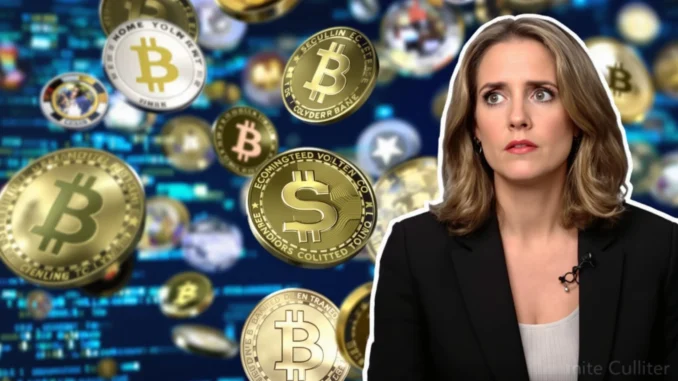
Is the Wild West of meme coins about to get even wilder? U.S. SEC Commissioner Caroline Crenshaw is raising serious alarms about the agency’s recent stance on meme coins, and her critique could send ripples across the cryptocurrency market. If you’re invested in Dogecoin, Shiba Inu, or any of the meme-inspired digital assets, you need to pay close attention. Let’s dive into why Crenshaw is sounding the alarm and what it means for the future of crypto regulation.
Why is the SEC’s Meme Coin Guidance Under Fire?
The Securities and Exchange Commission (SEC) recently issued guidance that seemingly puts meme coins in a separate category, suggesting they might fall outside the traditional regulatory framework. Commissioner Caroline Crenshaw is vehemently disagreeing. She argues this approach is not only incomplete but dangerously misleading. Here’s the crux of her argument:
- Meme coins are not just jokes: Crenshaw emphasizes that despite their playful origins and internet meme culture, these digital assets are created with the primary intention of making money for their issuers. They are financial products, plain and simple.
- Risk of regulatory loopholes: By suggesting meme coins are different, the SEC’s guidance could inadvertently create a loophole. Crypto firms might exploit this by simply labeling their tokens as ‘meme coins’ to evade necessary oversight.
- Investor protection at stake: Weak SEC guidance on meme coins means less protection for investors. These assets, often characterized by extreme volatility and hype-driven price swings, require robust regulatory scrutiny, not a lighter touch.
Crenshaw’s Critical Stance: A Blow to Crypto Firms Seeking Leniency?
Commissioner Crenshaw’s strong words are a clear signal that not everyone at the SEC is comfortable with a relaxed approach to meme coins. Her perspective is crucial because it highlights the potential dangers of under-regulating a significant segment of the cryptocurrency market. What exactly is she saying?
According to Crenshaw, the SEC’s guidance is flawed because it fails to acknowledge the economic realities of meme coins. She argues that the ‘meme’ label shouldn’t be a regulatory shield. Just because something starts as a joke doesn’t mean it can’t become a serious financial instrument with real-world consequences for investors.

The Real Danger: Meme Coins and Market Manipulation
One of the biggest concerns surrounding meme coins is their susceptibility to market manipulation. Fueled by social media hype and often lacking fundamental value, their prices can be easily swayed by coordinated pumps and dumps. Without proper cryptocurrency oversight, these schemes can thrive, leaving ordinary investors holding the bag.
Consider these points:
- Pump-and-dump schemes: Meme coins are prime targets for pump-and-dump schemes, where groups artificially inflate the price and then sell off their holdings, leaving others with losses.
- Lack of transparency: Many meme coin projects lack transparency regarding their development, token distribution, and long-term goals, making it harder for investors to assess their legitimacy.
- Volatility risks: The extreme volatility of meme coins makes them incredibly risky investments, especially for those new to the crypto market. Without regulatory safeguards, this risk is amplified.
What Does This Mean for Meme Coin Investors? Actionable Insights
Crenshaw’s criticism is a wake-up call for both regulators and investors in the meme coin space. So, what should you do if you’re involved with these digital assets?
- Stay Informed: Keep a close watch on regulatory developments, especially regarding meme coins. Crenshaw’s stance suggests potential future changes in how these assets are treated.
- Exercise Extreme Caution: Meme coins are high-risk investments. Never invest more than you can afford to lose. Understand the inherent volatility and the potential for significant losses.
- Due Diligence is Key: Before investing in any meme coin, try to do as much research as possible. Look beyond the hype and understand the project’s fundamentals (if any), team, and community.
- Advocate for Stronger Regulation: Support calls for clearer and more robust crypto regulation that doesn’t exempt meme coins simply because of their branding. Investor protection should be paramount.
Looking Ahead: Will the SEC Reconsider its Stance on Meme Coins?
Commissioner Crenshaw’s critique adds significant weight to the argument for stricter meme coins regulation. It remains to be seen whether the SEC will revise its guidance in light of these concerns. However, her vocal dissent signals a potential shift in the regulatory winds. The debate is far from over, and the future of meme coin regulation is still very much in play.
Conclusion: The Fight for Responsible Crypto Oversight
Caroline Crenshaw’s firm stance against lax meme coin regulation is a crucial development in the ongoing conversation about cryptocurrency oversight. Her warning serves as a potent reminder that all financial products, regardless of their branding or origin, must be subject to appropriate scrutiny to protect investors. As the crypto landscape continues to evolve, voices like Crenshaw’s are vital in ensuring that regulation keeps pace with innovation, without sacrificing investor safety for the sake of novelty. The message is clear: when it comes to investor protection, there’s no room for jokes.



